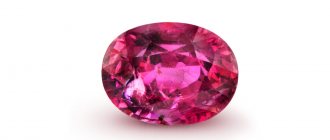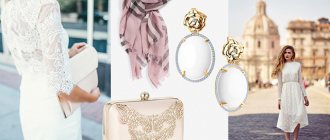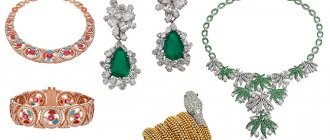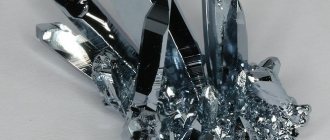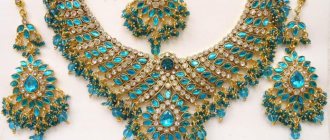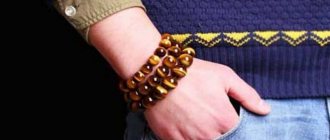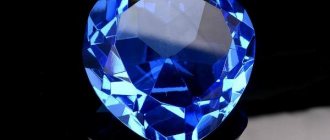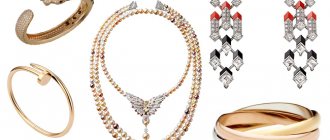Have you ever, while admiring jewelry, noticed that one of them costs much more than the rest, despite the fact that they are made from the same materials? But sometimes such differences are quite significant! But you shouldn’t think that a low price is an indicator of poor quality or careless work of the craftsman. The cost of the accessory varies depending on many features and nuances regarding the material from which it is made, the technique of work, the amount of effort expended and much more. And to help you choose a product that is both high-quality, attractive and inexpensive, a classification of jewelry was developed. Its principles, provisions and laws will be discussed in this article.
Variety of jewelry - practical classification
One of the most common ways to systematize accessories is to group them according to practical criteria. This classification method is quite widely used in the CIS countries and Europe.
When distributing accessories, craftsmen are guided by the material used in them. Thus, real jewelry includes only those that were made from noble metals - platinum, gold, silver . Such a product is decorated with any materials - from diamonds to glass - and may even have no inserts at all.
The next group is jewelry haberdashery. These are works created from non-precious alloys (aluminum, bronze, nickel) - but with silver or gold plating. They may or may not contain various decorative inserts, but in any case they will be made of non-precious substances.
And finally, the last class is metal haberdashery. This includes most items from the category of inexpensive jewelry. Both the product itself and the insert decorating it will be made of non-precious, commonly found materials - beads, leather, iron, plastic, polymer clay. However, such works are often very original and unique.
This classification is a modified version of an older system that existed before 1998. It consisted of four different classes - real jewelry, jewelry haberdashery, art and stone carvings. But due to scientific and technological progress, which entailed the invention of new materials and operating technologies, the typification was modified. Nevertheless, some masters still use it.
Precious or not - classification according to the material used
To understand what the cost of a certain accessory depends on, you need to be able to recognize the material from which it is made. It is on this basis that this typology was developed. Of course, a cast gold ring with a diamond or silver jewelry will cost much more than a craft made of nickel coated with a thin yellow plating!
So, precious metals include the following:
- gold . This ductile and soft noble metal is one of the oldest known to man. It has excellent heat and electrical conductivity and is easy to process. And the soft sparkle of the metal harmonizes perfectly with most precious stones;
- silver . It is harder than gold, but quite ductile and polishes well. Therefore, more detailed and practical works can be created from this metal;
- platinum . This metal is extremely rare. That is why it is classified as precious, although it is rarely used in jewelry - due to its hardness, platinum is difficult to process;
- palladium . Easily machined metal with a silver-gray color. It does not oxidize in air, which means that jewelry made from it will not darken over time;
- rhodium . This bluish-white metal is very hard and resistant to wear. In addition, it has extremely high reflectivity.
All other metals and alloys belong to the group of non-precious ones. But it is impossible to create such a clear classification of precious stones, because gems are evaluated based on a whole complex of signs and characteristics. Natural crystals may have inclusions or nuances of color (sometimes they cannot even be distinguished with the naked eye), which make an ordinary stone unique and exclusive - and therefore greatly increase its value.
Classification by purpose - what the product is used for
In addition to aesthetic ones, the accessories around us also perform utilitarian functions. The following typology, which is also used by our online jewelry store, is based on this principle. From the whole variety of jewelry, decorative items and everyday items, the following groups stand out:
- personal jewelry . As the name implies, these are works designed to highlight a person’s appearance - earrings, beads, pendants and pendants, rings and rings, rosary beads, medallions, etc.;
- things for the toilet . This type includes jewelry boxes, powder compacts, mirrors, and perfume bottles. Some researchers include hairpins, clips (for example, for ties or hats), cufflinks and pins in this category;
—
smoking accessories .
These are items such as pipes, mouthpieces, cigarette cases, ashtrays and similar accessories; - cutlery and crafts for table setting . These include spoons, forks, dishes, cups, decanters, coffee pots, napkin rings and even tea strainers!
- decorations for watches . They were popular in the 20th century, but even today you can see a man wearing a precious watch chain or a jewelry chronometer. And watches, bracelets, pendants and pendants with a clock mechanism are in great demand among ladies;
- souvenirs - coins, badges, medals, magnets;
- decorative elements of weapons - linings on the handles of knives and pistols, hilts, ceremonial scabbards;
— writing sets . They can be presented both as whole sets and as separate accessories - stationery knives, pens, inkwells, paperweights;
- decorative home furnishings - vases, candlesticks, lamps, clocks, panels and paintings, figurines and much more;
- items used for religious rituals - icons, incense, censers, candlesticks, baptismal fonts.
Monitoring compliance with assortment policy requirements
The program provides a means of operational monitoring of compliance with the requirements of the assortment policy - the “Analysis of Assortment Execution” report. Using the report, the user can establish two facts:
- the number of product items introduced into the assortment in each category corresponds to the established quotas;
- the quantity of goods in the store balance corresponds to the established quotas.
There are also reports that allow you to view quotas assigned to product brands/categories and a list of item items entered into the assortment.
Analysis of assortment execution
An indicator of the quality of work of a purchasing manager is Representation
on the shelf - the number of product items with a positive accounting balance at a user-specified point in time.
To quickly monitor the execution of the assortment policy established for a given store format, a report is provided Analysis of Assortment Execution
, available in the
Marketing->Marketing Reports->Assortment section.
The report displays product items that have been added to the assortment or have leftovers. For each position, the Filling
, if it is included in the assortment and
Representation
, if it has a positive balance in this store. The data is grouped by brands, categories, types of items, stores and formats. For each level, the absolute and relative deviation of the assortment representation on the shelf from the minimum of two values - quota and fullness - is calculated. Selecting the minimum value of two indicators allows you to divide responsibility for the result (product on the shelf) between the category manager and the product purchasing manager: after all, a quota can be assigned, but not filled in by the Assortment document.
The report highlights in red positions that have problem areas:
- Items that have leftovers but are not included in the assortment;
- Items of a permanent assortment that have no remaining stock in a given store.
These discrepancies are summarized at various levels of grouping. Thus, the situation when the quantitative representation is equal to the quota, but there are completely different products on the shelf, can also be analyzed by the user.
Total values of the Quota
is calculated as the sum of the maximum quota values established for a given brand/category in various stores, the indicators
Fullness
and
Representation
, as the number of different product items assigned to the assortment and having balances in different stores.
View current content
To the report Current assortment availability
displays data on the assortment of stores at a user-defined point in time. For each item included in the assortment, its role in the assortment, the stage of the life cycle of the item in the assortment of a certain format and the type of retail price are displayed. The data in the report is grouped by store formats, product types, and categories. For each grouping level, the number of different product items that are in the assortment at a specified point in time is displayed.
View current quotas
To view summary information on the quotas in force on the date entered by the user with acceptable deviation percentages, the program provides the Current assortment quotas
, available in
the Assortment of
in the Marketing section
.
The report is generated by store formats in accordance with the selection specified by the user.
Execution technique - how the jewelry is made
This sign is one of the most significant. It depends on him whether the pendant or ring you purchase will be exclusive and unique - or just another mass craft.
Today there are such varieties of execution techniques as machine, combined and manual. The machine provides for conveyor production of jewelry. A person participates in this process only at the most difficult stages, controlling quality and performing final operations. This is how unified jewelry is obtained - calibrated to the millimeter and standard. As a rule, they belong to the classic style.
The combined technology involves the manual assembly of individual parts of the accessory, obtained using machine techniques - stamping, pressing, casting. In addition, the master independently decorates the work with precious stones, overlays, adds a chain, clasp or lock, and performs final polishing and cleaning.
But, of course, it is best to buy handmade jewelry. As a rule, they are made in a single copy, which means you will be the owner of a rare and unique piece. These accessories are highly valued - after all, the craftsman spends a lot of time and effort on creating each of them, from project development to final finishing. And also unusual precious stones are often used in the work - for example, amber with inclusions or agate with an amazing pattern.
But, no matter what decoration you choose, you should like it and fit it. Only then will the accessory highlight your appearance and give you a lot of positive emotions!
Jewelry Styles
Each person chooses jewelry differently; most people pay attention to two factors: cost and appearance. And only after the buyer decides on these two criteria, other points begin to be taken into account: the type of precious metal, the type of precious stone or gem, the style of jewelry. It is precisely about the styles that exist in jewelry fashion that we would like to talk.
We can talk about the style of jewelry in two aspects:
- The professional classification of jewelry, which is generally accepted for any fashion and art, is a classification according to the type of era: Baroque, classicism, rococo, empire, modern and romanticism. Then, in the 20th century, modern movements appeared - cubism, abstract art, art deco, futurism and hi-tech. However, this is a truly specific classification used by jewelers, designers, artists, fashion houses and, occasionally, jewelry connoisseurs.
- The second classification was created specifically for amateurs, ordinary buyers: classic style, avant-garde, zoological style, ethnic style, Gothic style, geometric style, exotic style, cosmic style. This classification is more understandable to the consumer, because by the name you can immediately understand what exactly to expect from the jewelry. We will look at both classifications so that each buyer can understand what exactly he is choosing, what jewelry can be combined with and how to wear it.
Classic style - most jewelry brands work in this style, although they produce collections that are slightly different from the main trend. It is rare that a jewelry company adheres to a truly unified style; customer preferences are different, but it is the consumer’s needs that are the main thing in the jewelry market and global jewelry brands strive to satisfy them.
So, in the classic style they work: Damiani, BVLGARI, Links Of London, Tiffany, Cartier, Faberge, Chopard. We have listed only a small fraction of the existing jewelry companies that work primarily in this style, just as an example. So, what distinguishes the classic style: graceful forms, sophisticated, not too intricate, strict, laconic. The most common shape of jewelry is a circle or rectangle. The main advantage of this style is that it is not subject to fashion; they will be relevant anytime and anywhere, be it a work suit or an elegant evening dress.
The word avant-garde refers to more unusual decorations, which are characterized by the negation of all usual forms and traditions. Jewelry made in this style is subject to only one law - the talent, taste and desire of the jeweler. Usually this is shocking, eccentric, unusual, mobile, flexible, bright and catchy jewelry, which can combine unusual materials, precious stones coexist with semi-precious stones, and platinum coexist with leather. There are also no rules in using proportions and shapes of jewelry. The avant-garde style mainly includes: Very, Gavello, Style Avenue, Alexander Arne, La Nouvelle Bague, Mauboussin, Pomellato, Vhernier, Rossilver.
The next style is zoological , these are decorations that use figures of animals, birds, fish... in general, flora and fauna. Sometimes these collections look frivolous, sometimes cheerful, but at least one collection in a similar style can be found in any international jewelry brand, even the most elite brands. Moreover, almost all such jewelry can still be classified as classics.
Ethnic style , or also called folklore style. It is clear that all jewelry of this style interprets the motifs and culture of a certain nation or nationality: India, Spain, Japan, China, Russia…. For example, a typical representative of an ethnic style includes Celtic jewelry, or a characteristic Indian style. A narrower style is: exotic; in principle, it can be classified as an ethnic style. The decorations are made in bright, provocative and spectacular colors, for example, the closest to this direction is the African style. Brands that have ethnic collections are De Beers, Deno Silver, Bochic, John Hardy, Boucheron, Gianmaria Donin, Henry Dunay, La Nouvelle Bague.
The Gothic style is jewelry with ritual paraphernalia, crosses, gargoyles... in general, this style pays close attention to the symbolism of jewelry. You can clearly see a pentagram, runes or magical signs in the interweaving patterns; there are also elements of the Middle Ages, for example, openwork spiers of towers. Another subtype of this style is mourning products in dark, gloomy tones. Jewelry brands of this style are Le Sibille, Buccellati, Philipp Plein.
Now we move on to the professional classification and start with the Baroque - this is a luxurious decoration of jewelry with dynamic, lush and elaborate forms. The main features of this style: lush decor, no restraint, clarity, correctness, harmony. Heavy ornaments, garlands, bows, and curls predominate. Most often these are massive jewelry. Modern jewelry brands of this style are Buccellati, Carrera and Carrera.
Rococo style is lighter than Baroque. It is characterized by curved shapes, asymmetrical, bizarre combinations of all kinds of curls and garlands. In general, the Rococo style uses all kinds of twists and weaves; it is a fan-shaped composition: elegant, fragile, graceful. Many Russian jewelry brands work in this style: Sirin, Stela Exclusive.
Classicism style , please note, not to be confused with the classical style described above. This style is determined by the century of Ancient Greece and Roman antiquity. The main features of the style include: imitation of antiquity, mainly using the theme of laurel, oak, meander and acanthus. The color scheme is simple, soft, and not flashy; the most noticeable colors are black, red and white. The classicism style is characterized by strict and simple forms, most often medallions and rosettes. In this style you can see collections from Faberge, Tiffany, Versace.
Art Nouveau style is distinguished by a large number of smooth lines, elongated shapes, fluidity, asymmetry, and sophistication. The main theme in jewelry of this style is floral motifs, elegant compositions and the mystical flavor of things. What is important here is not the cost of precious stones or metals, but the meaning that they carry. What is important is not the combination of stones in terms of cost or quality, but in terms of color and esoteric meaning. Jewelry companies of this style: Konstantin Kryukov, Carlo Lucadella Quercia.
And concluding the conversation about jewelry styles, let’s dwell a little on modern styles. The main one is the art deco , which combines both luxury and simplicity, clear lines and a bright play of precious stones. The main brand and founder of the style is the jewelry brand Cartier, which creates jewelry full of harmony and elegance, but at the same time maintaining simple and understandable forms. Other brands also picked up this trend: VanCleef & Arpels, StefanHafner, Tiffany & Co, Chorard, Picchiotti, de Grissogono, Chaumet, Graff, Boucheron, Bruni, Adler.
High-tech style is minimalist forms and precious metals (Chaumet, Di Modolo). Mainly attention is paid to the quality of metal processing, but precious stones are rarely seen in jewelry of this style. Constructivism is subject to one idea: the form should reflect the name of the object and its purpose. It is here that the products most often found are transformers; jewelry in the constructivist style is multifunctional (Gavello, Orlando Orlandini).
As you can see, there are many styles, we only talked about the main directions, but within each style there are its own trends, substyles, and classifications. Therefore, a person, first of all, when choosing jewelry should be based on his own taste. In addition, being partial to one style does not exclude the presence of other styles in your home collection. Man is a changeable, multifaceted creature, so we quite often adapt to our mood: today we want to look strict, classic, and for this we select the appropriate styles. And tomorrow you want to have a little fun, take a break from your usual way of life and clear rules - it is for such occasions that jewelry of other styles is needed.

